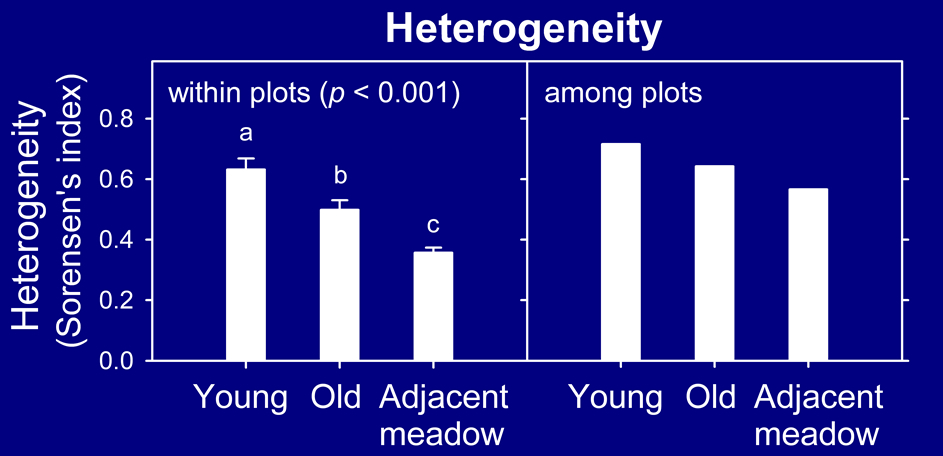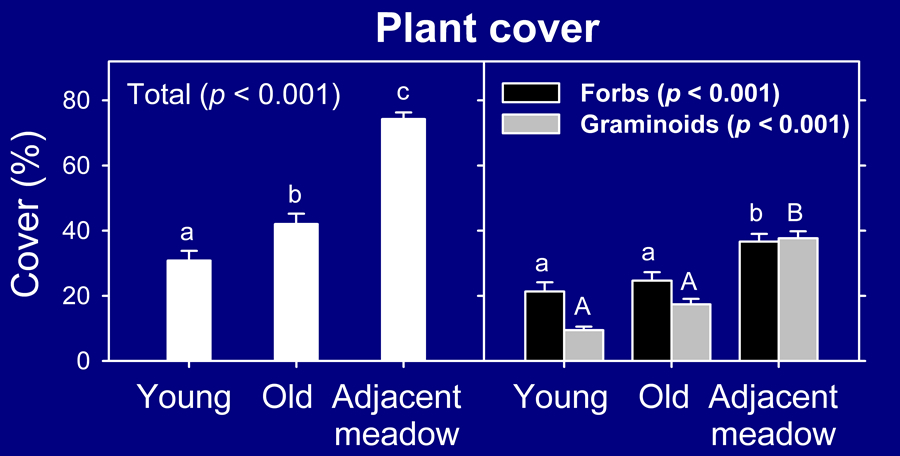| Results
Q1.
How do plant cover and species diversity change as mounds undergo
succession? Total
plant cover (figure, right: top panel) and species richness (figure,
right: bottom panel) increased with mound age, but old mounds had
lower cover and were less diverse than adjacent meadow.
Q2.
Does gopher activity shift the relative abundance of grasses vs. forbs?
Does this relationship change as mounds undergo succession? Relative
to graminoids, forbs benefited from mound formation, but this advantage
declined over time (figure, right: top right panel).
Q3.
Are communities of species on mounds more heterogeneous (variable)
in composition than those in adjacent meadows? Does this variability
decline as mounds succeed to meadow? At
both spatial scales (within and among plots), heterogeneity (variability)
of species composition was greatest for young mounds and declined
with age.
 |
| Changes
in heterogeneity at two scales (within plots and among
plots), as mounds undergo succession. The p-value
for within plot data is from one-way ANOVA; letters denote
significant differences among age classes. Significance
was not tested among plots due to non-independence of
comparisons. |
|
Q4.
Do mounds provide germination sites for species that
are absent from,
or uncommon in, undisturbed meadow? In
total,
34 species were observed among the 74 plots. All species
were found in meadow and 28 in mound plots. The six species unique
to meadow were uncommon.
Thus,
mounds did not support “fugitive” species that were
absent from undisturbed meadow. This is surprising given the abundance of ruderal species in the soil seed bank (see seed
bank study).
| Jones,
C. C., C. B. Halpern, and J. Niederer. 2008. Plant
succession on gopher mounds in western Cascade meadows: consequences
for species diversity and heterogeneity. American Midland
Naturalist 159:275-286. Request reprint |
|
 |
| Changes
in plant cover as mounds undergo succession. P-values
are from one-way ANOVA; letters denote significant differences
among age classes. |
|
 |
| Changes
in species richness at two scales (quadrats and plots),
as mounds undergo succession. P-values are from
one-way ANOVA; letters denote significant differences
among age classes. |
|
Conclusions
Plant
succession on gopher mounds is rapid, achieved through resprouting
of buried plants and lateral growth of plants in adjacent meadow.
Although mound creation does not enhance the diversity of species that inhabit meadows, it does have two important ecological effects:
- it
reduces dominance of graminoids that would outcompete forbs in
the absence of disturbance
- it
increases spatial variability in species composition, creating
new patches that support differing, and less predictable, combinations
of species
In
the absence of gophers, meadows that currently support a diverse
array of forbs and graminoids would become increasingly dominated
by a small number of grasses and sedges.

|
![]()
![]()
![]()
![]()


